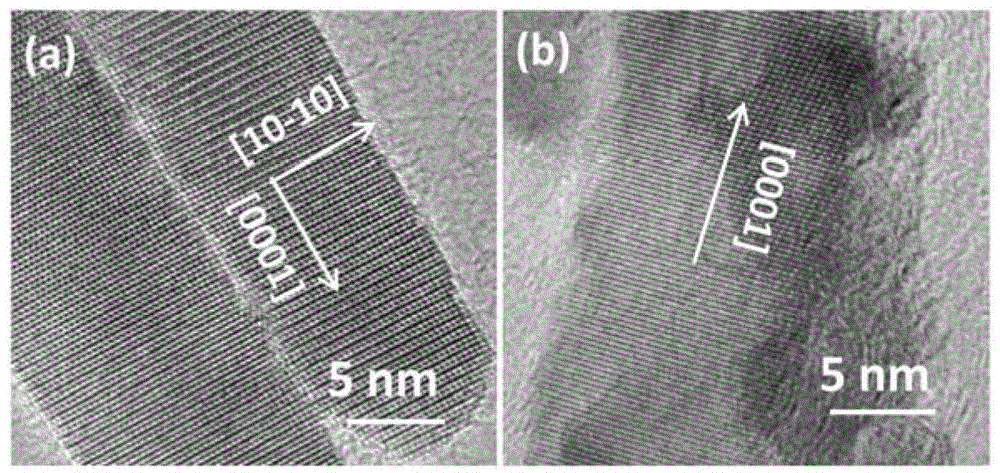Organic-inorganic hybrid nano material, and preparation method and application thereof
A technology of nanomaterials and organic compounds, applied in the field of organic-inorganic hybrid nanomaterials and its preparation and application, can solve the problems that the performance has not reached the highest level of all organic photoelectric devices, and achieve effective hierarchical electron transfer, excellent performance, and excellent optoelectronics performance effect
- Summary
- Abstract
- Description
- Claims
- Application Information
AI Technical Summary
Problems solved by technology
Method used
Image
Examples
Embodiment 1
[0059] Embodiment 1, organic-inorganic hybrid nanomaterial and photoelectric performance test thereof
[0060] (1) Preparation of carboxyl-containing perylene imide derivative 1T-PBI
[0061] The reaction equation is as follows:
[0062]
[0063] First synthesize the precursor compound formula A-1:
[0064] 0.50 g of 1,7-dibromo-3,4,9,10-perylenetetraanhydride and 0.30 g of tert-butyl glycine hydrochloride, dissolved in water, a mixed solvent of n-butanol and triethylamine, at 85 ° The reaction was stirred at C for 48 hours. After the reaction was completed, the solvent was removed by distillation under reduced pressure to obtain a crude product. The crude product was separated and purified by silica gel chromatography, the eluent was chloroform:methanol=500:3, and the red product formula A-1 was obtained with a yield of 38%.
[0065] Get 44 milligrams of gained A-1 product and dissolve in anhydrous toluene, lead to Ar gas protection, add the Pd (PPh 3 ) 2 Cl 2 , rea...
Embodiment 2
[0079] Embodiment 2, organic-inorganic hybrid nanomaterials and photoelectric performance tests thereof
[0080] (1) Preparation of carboxyl-containing perylene imide derivative 2T-PBI
[0081] The reaction equation is as follows:
[0082]
[0083] First synthesize 1-hexyl-5-tributyltin-2,2-dithiophene:
[0084] 1.0 g of 1-hexyl-2,2-dithiophene was dissolved in THF, then 3.54 ml of n-butyllithium was added dropwise, and stirred at -78°C for 0.5 h in an Ar atmosphere. Added 1.96 ml of tributyltin chloride and stirred at room temperature for 6h. The solvent was spin-dried, dissolved in n-hexane, and then filtered to obtain 1-hexyl-5-tributyltin-2,2-dithiophene with a yield of 70%.
[0085] The dry 50 ml three-necked round-bottomed flask was blown with Ar gas for 30 minutes, removed the air, and added 0.2 gram of compound A-1 (as shown in formula II), 5 mg of Pd (II) (PPh 3 ) 2 Cl 2 , 0.30 g of 1-hexyl-5-tributyltin-2,2-dithiophene was dissolved in anhydrous toluene, mai...
Embodiment 3
[0099] Embodiment 3, organic-inorganic hybrid nanomaterials and photoelectric performance test thereof
[0100] (1) Synthesis of TTDPP
[0101] The reaction equation is as follows:
[0102]
[0103] Synthesis of 2-hexyl-5-trimethyltinthiophene:
[0104] Under a nitrogen atmosphere, dissolve 400 mg of 2-hexylthiophene in re-evaporated and dried THF and place in a high-pressure reaction flask, then cool to -78°C, and then add 1 ml of 2.2 mol in n-hexane dropwise. / L of n-butyllithium solution, stirred at low temperature for 1 h, and then added 2.2 ml of trimethyltin chloride dispersed in n-hexane with a concentration of 1 mol / L. Stir at room temperature for 2h. After the reaction, the solution was diluted into saline and extracted with ethyl acetate, and then dried with anhydrous magnesium sulfate, and the next reaction was carried out directly.
[0105] Synthesis of Precursor B-1:
[0106] 13 grams of cyanothiophene, 4.87 grams of dimethyl succinate and excess sodium te...
PUM
 Login to View More
Login to View More Abstract
Description
Claims
Application Information
 Login to View More
Login to View More - R&D
- Intellectual Property
- Life Sciences
- Materials
- Tech Scout
- Unparalleled Data Quality
- Higher Quality Content
- 60% Fewer Hallucinations
Browse by: Latest US Patents, China's latest patents, Technical Efficacy Thesaurus, Application Domain, Technology Topic, Popular Technical Reports.
© 2025 PatSnap. All rights reserved.Legal|Privacy policy|Modern Slavery Act Transparency Statement|Sitemap|About US| Contact US: help@patsnap.com



